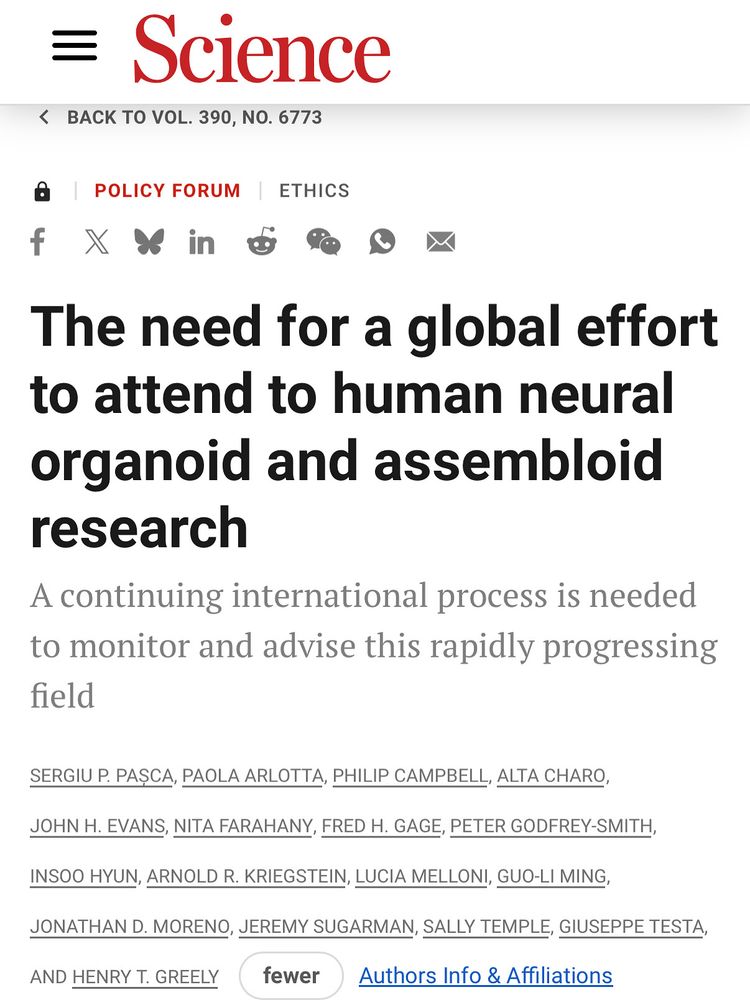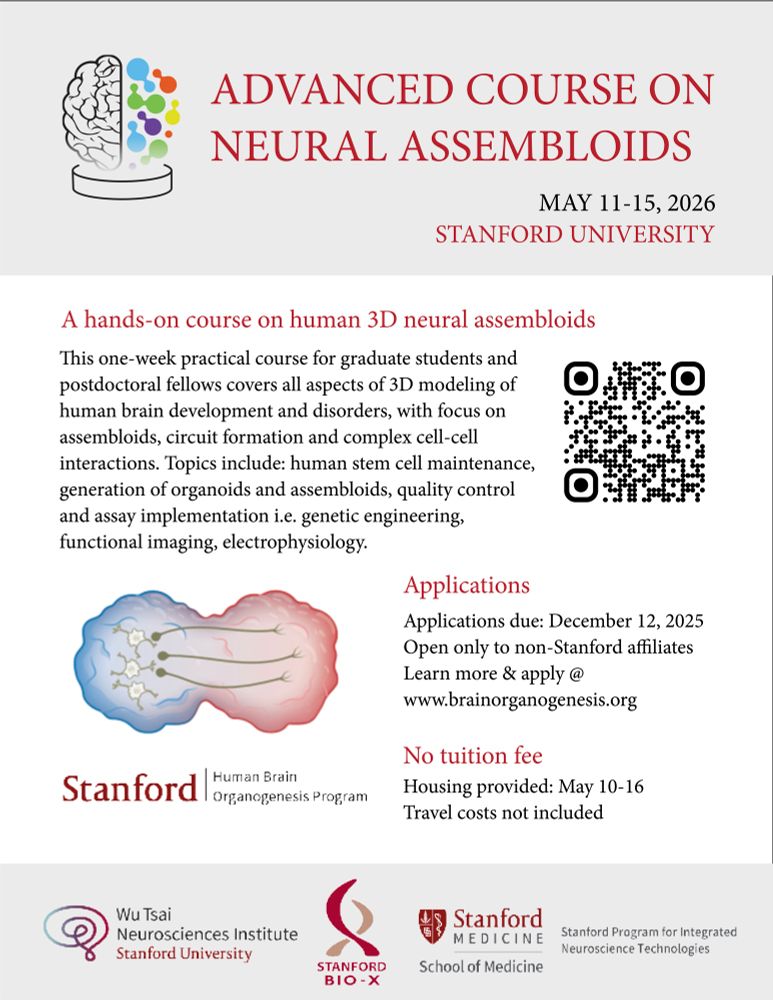This afternoon we welcome Dr. Jimena Andersen of Emory University, who will present “Cortico-motor Assembloids: A Human 3D Multi-cellular Platform to Study Spinal Cord Development and Disease.” burke.weill.cornell.edu/events/corti...

Cortico-motor assembloids: a human 3D multi-cellular platform to study spinal cord development and disease
AbstractResearch in the Andersen lab leverages the use of region-specific organoids and assembloids as windows into unique aspects of human biology.Specifically, we are interested in understanding…
burke.weill.cornell.edu
November 11, 2025 at 4:30 PM
This afternoon we welcome Dr. Jimena Andersen of Emory University, who will present “Cortico-motor Assembloids: A Human 3D Multi-cellular Platform to Study Spinal Cord Development and Disease.” burke.weill.cornell.edu/events/corti...
Human heart-macrophage assembloids mimic immune-cardiac interactions and enable arrhythmia disease modeling

Human heart-macrophage assembloids mimic immune-cardiac interactions and enable arrhythmia disease modeling
O’Hern et al. present a novel human heart-macrophage assembloid platform generated by integrating hPSC-derived embryonic monocytes into heart organoids. These tissue-resident macrophages regulate cardiac development and conduction and, under chronic inflammation, recapitulate atrial fibrillation features, offering a powerful model to study immune-cardiac interactions and arrhythmia mechanisms.
dlvr.it
November 7, 2025 at 8:09 PM
Human heart-macrophage assembloids mimic immune-cardiac interactions and enable arrhythmia disease modeling
can organoids/assembloids actually suffer? could we consider that mature ones might have some kind of simple consciousness? if that’s the case, is it (bio)ethical to use them for biomedical research? maybe okay for testing drugs to treat disease, but not for enhancement? where do we draw the line?
Brain organoids are getting better at mimicking brains in a dish. But how good is too good? I take a look at the latest developments in my story today in the Times. Gift link: nyti.ms/496PPnC
nyti.ms
November 7, 2025 at 2:22 PM
can organoids/assembloids actually suffer? could we consider that mature ones might have some kind of simple consciousness? if that’s the case, is it (bio)ethical to use them for biomedical research? maybe okay for testing drugs to treat disease, but not for enhancement? where do we draw the line?
This week, we published in @science.org an article outlining the current ethical and societal implications of research involving human neural #organoids and #assembloids, their transplantation, and highlighted potential next steps.

November 7, 2025 at 12:12 PM
This week, we published in @science.org an article outlining the current ethical and societal implications of research involving human neural #organoids and #assembloids, their transplantation, and highlighted potential next steps.
Interesting new work modeling human cholinergic circuitry! Researchers generated nbM organoids from hPSCs and fused them with cortical organoids to form functional nbM–cortical assembloids. This provides a platform to study deficits seen in Down syndrome. @cp-cellstemcell.bsky.social

November 4, 2025 at 5:14 PM
Interesting new work modeling human cholinergic circuitry! Researchers generated nbM organoids from hPSCs and fused them with cortical organoids to form functional nbM–cortical assembloids. This provides a platform to study deficits seen in Down syndrome. @cp-cellstemcell.bsky.social
Online Now! Generation of human nucleus basalis organoids with functional nbM-cortical cholinergic projections in transplanted assembloids #stemcells

Generation of human nucleus basalis organoids with functional nbM-cortical cholinergic projections in transplanted assembloids
The nucleus basalis of Meynert (nbM) regulates cortical function and cognition. Liu and colleagues report a method for creating human nbM organoids (hnbMOs) containing cholinergic projection neurons that form functional connections with the cortex. This work provides a model to investigate nbM circuits and cholinergic dysfunction in neurological disorders.
dlvr.it
November 3, 2025 at 3:10 PM
Online Now! Generation of human nucleus basalis organoids with functional nbM-cortical cholinergic projections in transplanted assembloids #stemcells
Single-chain TS2/16 integrin β1-activating antibody as a soluble supplement
up to 10-fold ⏫ yields of 2D/3D Visceral (small intestine, colon, stomach, pancreas/liver) Organoids🤠
Impact on blood vessel organoids/assembloids?😆
@hansclevers.bsky.social #NatBiotech 2025
www.nature.com/articles/s41...
up to 10-fold ⏫ yields of 2D/3D Visceral (small intestine, colon, stomach, pancreas/liver) Organoids🤠
Impact on blood vessel organoids/assembloids?😆
@hansclevers.bsky.social #NatBiotech 2025
www.nature.com/articles/s41...

October 31, 2025 at 12:10 PM
Single-chain TS2/16 integrin β1-activating antibody as a soluble supplement
up to 10-fold ⏫ yields of 2D/3D Visceral (small intestine, colon, stomach, pancreas/liver) Organoids🤠
Impact on blood vessel organoids/assembloids?😆
@hansclevers.bsky.social #NatBiotech 2025
www.nature.com/articles/s41...
up to 10-fold ⏫ yields of 2D/3D Visceral (small intestine, colon, stomach, pancreas/liver) Organoids🤠
Impact on blood vessel organoids/assembloids?😆
@hansclevers.bsky.social #NatBiotech 2025
www.nature.com/articles/s41...
.@sergiuppasca.bsky.social is one of neuroscience's most remarkable young investigators. His assembloids, organized clusters of brain cells that form recognizable regions and connections, have solved an old problem. More: explorers.com/sergiu-p-pas...




October 30, 2025 at 3:06 PM
.@sergiuppasca.bsky.social is one of neuroscience's most remarkable young investigators. His assembloids, organized clusters of brain cells that form recognizable regions and connections, have solved an old problem. More: explorers.com/sergiu-p-pas...
In this preprint, Purdue researchers, including @tegtmeyerlab.bsky.social, built region-specific brain #organoids with #microglia to model circuits tied to depression and uncovered unique roles for these cells.
www.biorxiv.org/content/10.1...
www.biorxiv.org/content/10.1...

October 30, 2025 at 1:51 PM
In this preprint, Purdue researchers, including @tegtmeyerlab.bsky.social, built region-specific brain #organoids with #microglia to model circuits tied to depression and uncovered unique roles for these cells.
www.biorxiv.org/content/10.1...
www.biorxiv.org/content/10.1...
Online Now! Human heart-macrophage assembloids mimic immune-cardiac interactions and enable arrhythmia disease modeling #stemcells

Human heart-macrophage assembloids mimic immune-cardiac interactions and enable arrhythmia disease modeling
O’Hern et al. present a novel human heart-macrophage assembloid platform generated by integrating hPSC-derived embryonic monocytes into heart organoids. These tissue-resident macrophages regulate cardiac development and conduction and, under chronic inflammation, recapitulate atrial fibrillation features, offering a powerful model to study immune-cardiac interactions and arrhythmia mechanisms.
dlvr.it
October 27, 2025 at 7:09 PM
Online Now! Human heart-macrophage assembloids mimic immune-cardiac interactions and enable arrhythmia disease modeling #stemcells
Our new paper in Cell Stem Cell introduces human heart–macrophage assembloids — the first, highly sophisticated organoid model of immune–cardiac interactions.
#NAMs #Organoids #CardiacResearch #CellStemCell #AFib #NIH #MSU
Link to the paper: www.cell.com/cell-stem-ce...
#NAMs #Organoids #CardiacResearch #CellStemCell #AFib #NIH #MSU
Link to the paper: www.cell.com/cell-stem-ce...

Human heart-macrophage assembloids mimic immune-cardiac interactions and enable arrhythmia disease modeling
O’Hern et al. present a novel human heart-macrophage assembloid platform generated
by integrating hPSC-derived embryonic monocytes into heart organoids. These tissue-resident
macrophages regulate card...
www.cell.com
October 27, 2025 at 6:29 PM
Our new paper in Cell Stem Cell introduces human heart–macrophage assembloids — the first, highly sophisticated organoid model of immune–cardiac interactions.
#NAMs #Organoids #CardiacResearch #CellStemCell #AFib #NIH #MSU
Link to the paper: www.cell.com/cell-stem-ce...
#NAMs #Organoids #CardiacResearch #CellStemCell #AFib #NIH #MSU
Link to the paper: www.cell.com/cell-stem-ce...
Interregional human assembloids recapitulate fetal brain morphologies and enhance neuronal complexity #SingleCell 🧪🧬🖥️
https://www.biorxiv.org/content/10.1101/2025.10.24.684445v1
https://www.biorxiv.org/content/10.1101/2025.10.24.684445v1
October 25, 2025 at 4:00 PM
Interregional human assembloids recapitulate fetal brain morphologies and enhance neuronal complexity #SingleCell 🧪🧬🖥️
https://www.biorxiv.org/content/10.1101/2025.10.24.684445v1
https://www.biorxiv.org/content/10.1101/2025.10.24.684445v1
Interregional human assembloids recapitulate fetal brain morphologies and enhance neuronal complexity https://www.biorxiv.org/content/10.1101/2025.10.24.684445v1
October 25, 2025 at 8:15 AM
Interregional human assembloids recapitulate fetal brain morphologies and enhance neuronal complexity https://www.biorxiv.org/content/10.1101/2025.10.24.684445v1
Interregional human assembloids recapitulate fetal brain morphologies and enhance neuronal complexity https://www.biorxiv.org/content/10.1101/2025.10.24.684445v1
October 25, 2025 at 8:15 AM
Interregional human assembloids recapitulate fetal brain morphologies and enhance neuronal complexity https://www.biorxiv.org/content/10.1101/2025.10.24.684445v1

October 23, 2025 at 10:40 PM
Human cortico-vascular assembloids reveal a CELF2-AHNAK-dependent switch from neuronal to endothelial tropism in glioblastoma cells https://www.biorxiv.org/content/10.1101/2025.10.21.683634v1
October 22, 2025 at 7:48 PM
Human cortico-vascular assembloids reveal a CELF2-AHNAK-dependent switch from neuronal to endothelial tropism in glioblastoma cells https://www.biorxiv.org/content/10.1101/2025.10.21.683634v1
Human cortico-vascular assembloids reveal a CELF2-AHNAK-dependent switch from neuronal to endothelial tropism in glioblastoma cells https://www.biorxiv.org/content/10.1101/2025.10.21.683634v1
October 22, 2025 at 7:48 PM
Human cortico-vascular assembloids reveal a CELF2-AHNAK-dependent switch from neuronal to endothelial tropism in glioblastoma cells https://www.biorxiv.org/content/10.1101/2025.10.21.683634v1
Call for papers: In Vitro Models of Human Disease to Inform Mechanism and Drug Discovery
Deadline approaching: Monday 3 November 2025
journals.biologists.com/dmm/pages/in...
#Biology #Research #Disease #Discovery #Organoids #Tumours #Gastruloids #Assembloids
Deadline approaching: Monday 3 November 2025
journals.biologists.com/dmm/pages/in...
#Biology #Research #Disease #Discovery #Organoids #Tumours #Gastruloids #Assembloids

October 20, 2025 at 2:25 PM
Call for papers: In Vitro Models of Human Disease to Inform Mechanism and Drug Discovery
Deadline approaching: Monday 3 November 2025
journals.biologists.com/dmm/pages/in...
#Biology #Research #Disease #Discovery #Organoids #Tumours #Gastruloids #Assembloids
Deadline approaching: Monday 3 November 2025
journals.biologists.com/dmm/pages/in...
#Biology #Research #Disease #Discovery #Organoids #Tumours #Gastruloids #Assembloids
Modeling Alzheimer's Disease with APOE4 Neuron-Glial Brain Assembloids Reveals IGFBPs as Therapeutic Targets #NeuroDegeneration 🧪🧠
https://www.biorxiv.org/content/10.1101/2025.10.17.683162v1
https://www.biorxiv.org/content/10.1101/2025.10.17.683162v1
October 19, 2025 at 4:02 PM
Modeling Alzheimer's Disease with APOE4 Neuron-Glial Brain Assembloids Reveals IGFBPs as Therapeutic Targets #NeuroDegeneration 🧪🧠
https://www.biorxiv.org/content/10.1101/2025.10.17.683162v1
https://www.biorxiv.org/content/10.1101/2025.10.17.683162v1
Modeling Alzheimer's Disease with APOE4 Neuron-Glial Brain Assembloids Reveals IGFBPs as Therapeutic Targets #SingleCell 🧪🧬🖥️
https://www.biorxiv.org/content/10.1101/2025.10.17.683162v1
https://www.biorxiv.org/content/10.1101/2025.10.17.683162v1
October 19, 2025 at 4:00 PM
Modeling Alzheimer's Disease with APOE4 Neuron-Glial Brain Assembloids Reveals IGFBPs as Therapeutic Targets #SingleCell 🧪🧬🖥️
https://www.biorxiv.org/content/10.1101/2025.10.17.683162v1
https://www.biorxiv.org/content/10.1101/2025.10.17.683162v1
Modeling Alzheimer's Disease with APOE4 Neuron-Glial Brain Assembloids Reveals IGFBPs as Therapeutic Targets https://www.biorxiv.org/content/10.1101/2025.10.17.683162v1
October 19, 2025 at 10:15 AM
Modeling Alzheimer's Disease with APOE4 Neuron-Glial Brain Assembloids Reveals IGFBPs as Therapeutic Targets https://www.biorxiv.org/content/10.1101/2025.10.17.683162v1
Modeling Alzheimer's Disease with APOE4 Neuron-Glial Brain Assembloids Reveals IGFBPs as Therapeutic Targets https://www.biorxiv.org/content/10.1101/2025.10.17.683162v1
October 19, 2025 at 10:15 AM
Modeling Alzheimer's Disease with APOE4 Neuron-Glial Brain Assembloids Reveals IGFBPs as Therapeutic Targets https://www.biorxiv.org/content/10.1101/2025.10.17.683162v1
We use CODA to map human endometrial tissue at single-cell resolution, a map that then serves as a blueprint to design a multi-compartment multicellular assembloid of the endometrium.
Read about our approach to organoids/assembloids here: www.biorxiv.org/content/10.1...
Read about our approach to organoids/assembloids here: www.biorxiv.org/content/10.1...

October 18, 2025 at 3:41 PM
We use CODA to map human endometrial tissue at single-cell resolution, a map that then serves as a blueprint to design a multi-compartment multicellular assembloid of the endometrium.
Read about our approach to organoids/assembloids here: www.biorxiv.org/content/10.1...
Read about our approach to organoids/assembloids here: www.biorxiv.org/content/10.1...
Looking forward to this collab with @moritzmall.bsky.social and Barbara Treutlein!
We’ll generate high-throughput multi-modal CRISPR data on ASD risk genes in 🧠 organoids & assembloids, and build an ML model of gene regulation dynamics to analyze the data and enable future in silico experiments.
We’ll generate high-throughput multi-modal CRISPR data on ASD risk genes in 🧠 organoids & assembloids, and build an ML model of gene regulation dynamics to analyze the data and enable future in silico experiments.
Presenting recipients of our 2025 Stimulator Grant:
👉TACTICS: Thalamocortical Assembloids and Computational Tools for Investigating Cellular Signatures in #Autism.
🧠How do autism-linked mutations disrupt early brain development? @moritzmall.bsky.social @steglelab.bsky.social
@dkfz.bsky.social
👉TACTICS: Thalamocortical Assembloids and Computational Tools for Investigating Cellular Signatures in #Autism.
🧠How do autism-linked mutations disrupt early brain development? @moritzmall.bsky.social @steglelab.bsky.social
@dkfz.bsky.social

October 14, 2025 at 11:42 AM
Looking forward to this collab with @moritzmall.bsky.social and Barbara Treutlein!
We’ll generate high-throughput multi-modal CRISPR data on ASD risk genes in 🧠 organoids & assembloids, and build an ML model of gene regulation dynamics to analyze the data and enable future in silico experiments.
We’ll generate high-throughput multi-modal CRISPR data on ASD risk genes in 🧠 organoids & assembloids, and build an ML model of gene regulation dynamics to analyze the data and enable future in silico experiments.
Presenting recipients of our 2025 Stimulator Grant:
👉TACTICS: Thalamocortical Assembloids and Computational Tools for Investigating Cellular Signatures in #Autism.
🧠How do autism-linked mutations disrupt early brain development? @moritzmall.bsky.social @steglelab.bsky.social
@dkfz.bsky.social
👉TACTICS: Thalamocortical Assembloids and Computational Tools for Investigating Cellular Signatures in #Autism.
🧠How do autism-linked mutations disrupt early brain development? @moritzmall.bsky.social @steglelab.bsky.social
@dkfz.bsky.social

October 13, 2025 at 2:19 PM
Presenting recipients of our 2025 Stimulator Grant:
👉TACTICS: Thalamocortical Assembloids and Computational Tools for Investigating Cellular Signatures in #Autism.
🧠How do autism-linked mutations disrupt early brain development? @moritzmall.bsky.social @steglelab.bsky.social
@dkfz.bsky.social
👉TACTICS: Thalamocortical Assembloids and Computational Tools for Investigating Cellular Signatures in #Autism.
🧠How do autism-linked mutations disrupt early brain development? @moritzmall.bsky.social @steglelab.bsky.social
@dkfz.bsky.social

